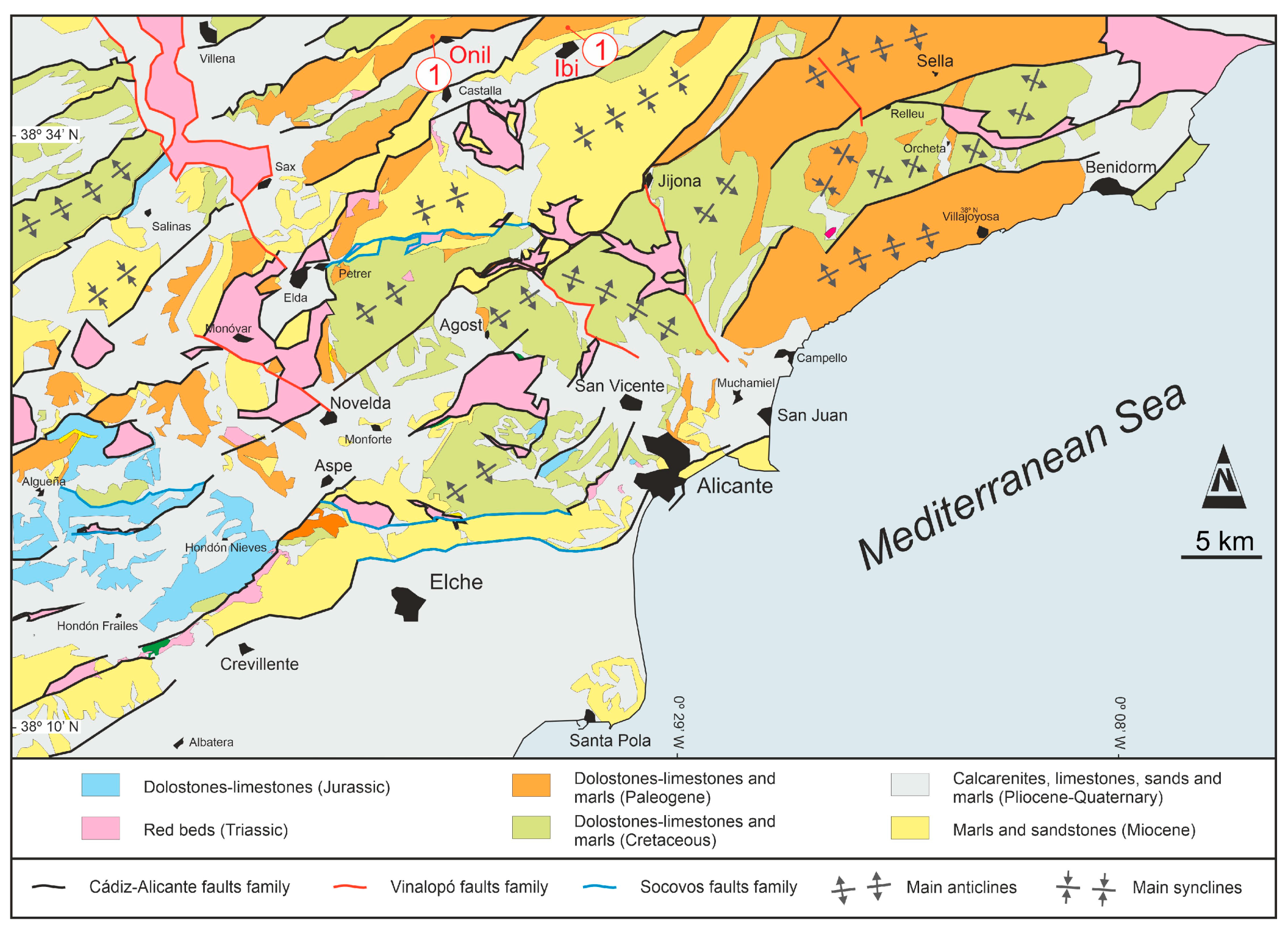Eocene Stratigraphic Sequences in the Prebetic of Alicante (SE Spain) and Their Correlation with Global Sea-Level and Climatic Curves
Abstract
1. Introduction
2. Geological Setting
3. Materials and Methods
4. Results
4.1. Lithofacies Analysis
4.2. Biostratigraphic Data and Biochronologic Correlation
4.3. Microfacies Analysis and the Depositional Environment
5. Discussion
5.1. Carbonate Factory and Accommodation Controls
5.2. Low- and High-Frequency Sequences: LFSs and HFSs
5.3. Correlation with Global Eocene Curves
6. Conclusions
- −
- Seven lithofacies were identified: Alveolina limestone (L1), limestone with nummulitids (L2), algal limestone (L3), limestone with miliolids (L4), terrigenous limestone (L5), dolomitized limestone (L6), and greenish mudstone (L7).
- −
- Based on larger benthic foraminifera (LBF) and planktonic foraminifera, the sections were biostratigraphically dated as late Early Eocene (middle Cuisian from the late Ypresian) to early Middle Eocene (early Lutetian) (~51–43 Myr).
- −
- Five microfacies (Mf1–Mf5) were defined, indicating inner- to mid-ramp environments: shoal inner-ramp (Mf1), seagrass inner-ramp (Mf2), LBF accumulations in the inner- to mid-ramp transition (Mf3), Maërl mid-ramp (Mf4), and LBF accumulations in mid-ramp (Mf5).
- −
- The dominance of LBF, dasycladale algae, and crustose coralline algae suggests warm-water, low-latitude conditions.
- −
- The particular composition of these platforms (dominated by LBF in association with rhodophyceae but lacking coral reefs) leaded us to cautiously propose the recognition of a distinct warm-temperate carbonate factory, termed here as a TC-factory (temperate carbonate factory).
- −
- The integration of field data, drone imagery, and microfacies analysis revealed a framework of lower-frequency sequences (LFSs) composed of high-frequency sequences (HFSs), both representing transgressive–regressive (TR) cycles. Five LFSs were identified in both sections, each containing different numbers of HFSs. In turn, the LBSs belong to a higher-rank sequence bounded by regional unconformities.
- −
- LFSs (~2 Myr average duration) may correspond to third-order sequences (linked to tectonic/climatic shifts), while HFSs (~0.25 to ~1 Myr) correspond to fourth-order sequences (typically tied to Milankovitch cycles). However, both LFSs and HFSs reflect the various interplays of local and global controls that prevent the development of any supposed orderly cyclicity in real sedimentary basins, which led several authors to try to untie sequence stratigraphic analysis from spatial and temporal scales. Consequently, the five LFSs only broadly match the upper Ypresian and lower Lutetian cycles in global eustatic curves (~51–43 Myr), indicating that other controls (e.g., tectonics) were also important.
- −
- The number of HFSs is consistently lower than expected for orbital curves, raising some questions about their origin. Potential other controls include accommodation changes related to local pulsed tectonics, erosional truncation of cycles of orbital origin during sea level lowstands, accommodation generation by carbonate factories, or the interplay of all or part of the above processes.
- −
- Further studies are needed to be more specific on the origin of the deviation of studied cycles from global models and to document, in a formal way, the newly proposed factory for temperate carbonate platforms.
Author Contributions
Funding
Data Availability Statement
Acknowledgments
Conflicts of Interest
References
- Vail, P.R.; Mitchum, R.M., Jr.; Thompson, S. Seismic stratigraphy and global changes of sea level, Part 3: Relative changes of sea level from coastal onlap. In Seismic Stratigraphy—Applications to Hydrocarbon Exploration; Payton, C.E., Ed.; AAPG Memoir 26; AAPG: Tulsa, OK, USA, 1977; pp. 63–81. [Google Scholar]
- Vail, P.R.; Todd, R.G.; Sangree, J.B. Seismic stratigraphy and global changes of sea level, Part 5. Chronostratigraphic significance of Seismic Reflections: Section 2. Application of Seismic reflection configuration to stratigraphic interpretation. In Seismic Stratigraphy—Applications to Hydrocarbon Exploration; Payton, C.E., Ed.; AAPG Memoir 26; AAPG: Tulsa, OK, USA, 1977; pp. 99–116. [Google Scholar]
- Mitchum, R.M.; Vail, P.R.; Thompson, S.I.I.I. Seismic stratigraphy and global changes of sea level, Part 2: The depositional sequence as a basic unit for stratigraphic analysis. In Seismic Stratigraphy—Application to Hydrocarbon Exploration; Payton, C.E., Ed.; AAPG Memoir 26; AAPG: Tulsa, OK, USA, 1977; pp. 53–62. [Google Scholar]
- Van Wagoner, J.C.; Posamentier, H.W.; Mitchum, R.M.; Vail, P.R.; Sarg, T.S.; Loutit, T.S.; Hardenbol, J. On overview of the fundamentals of sequence stratigraphy and key definitions. In Sea-Level Changes: An Integrated Approach; Wilgus, C.K., Hartings, B.S., Posamentier, H., Van Wagoner, J., Ross, C.A., Kendall, C.G.S.C., Eds.; SEPM Special Publication: Claremore, OK, USA, 1988; Volume 42, pp. 40–45. [Google Scholar]
- Jervey, M.T. Quantitative geological modeling of siliciclastic rock sequences and their seismic expression. In Sea-Level Changes: An Integrated Approach; Wilgus, C.K., Hastings, B.S., Kendall, C.G.S.C., Posamentier, H.W., Ross, C.A., Van Wagoner, J.C., Eds.; SEPM Special Publication: Claremore, OK, USA, 1988; Volume 42, pp. 47–69. [Google Scholar]
- Posamentier, H.; Vail, P.R. Eustatic controls on clastic deposition II—Sequences and systems tract models. In Sea Level Changes—An Integrated Approach; Wilgus, C.K., Hastings, B.S., Posamentier, H., Van Wagoner, J., Ross, C.A., Kendall, C.G.S.C., Eds.; SEPM Special Publication: Claremore, OK, USA, 1988; Volume 42, pp. 125–154. [Google Scholar]
- Catuneanu, O.; Galloway, W.E.; Kendall, C.G.S.C.; Miall, A.D.; Posamentier, H.W.; Strasser, A.; Tucker, M.E. Sequence stratigraphy: Methodology and nomenclature. Newsl. Stratigr. 2011, 44, 173–245. [Google Scholar] [CrossRef]
- Catuneanu, O. Model-independent sequence stratigraphy. Earth-Sci. Rev. 2019, 188, 312–388. [Google Scholar] [CrossRef]
- Catuneanu, O. Scale in sequence stratigraphy. Mar. Pet. Geol. 2019, 106, 128–159. [Google Scholar] [CrossRef]
- Catuneanu, O. Principles of Sequence Stratigraphy, 2nd ed.; Elsevier: Amsterdam, The Netherlands, 2022; p. 486. [Google Scholar]
- Mial, A.D. Stratigraphy: A Modern Synthesis; Springer: Cham, Switzerland, 2022; p. 511. [Google Scholar]
- Schlager, W. Accommodation and sediment supply—A dual control on stratigraphic sequences. Sediment. Geol. 1993, 86, 111–136. [Google Scholar] [CrossRef]
- Vail, P.R. Seismic stratigraphy interpretation using sequence stratigraphy, Part 1: Seismic stratigraphy interpretation procedure. In Atlas of Seismic Stratigraphy; Bally, A.W., Ed.; AAPG Studies in Geology: Tulsa, OK, USA, 1987; Volume 27, pp. 1–10. [Google Scholar]
- Sarg, J.F. Carbonate sequence stratigraphy. In Sea-Level Changes: An Integrated Approach; Wilgus, C.K., Hastings, B.S., Kendall, C.G.S.C., Posamentier, H.W., Ross, C.A., Van Wagoner, J.C., Eds.; SEPM Special Publication: Claremore, OK, USA, 1988; Volume 42, pp. 155–182. [Google Scholar]
- Schlager, W. Drowning unconformities on carbonate platforms. In Controls on Carbonate Platform and Basin Development; Crevello, P.D., Sarg, J.F., Wilson, J.L., Read, J.F., Eds.; SEPM Special Publication: Claremore, OK, USA, 1989; Volume 44, pp. 15–25. [Google Scholar]
- Schlager, W. Sedimentology and Sequence Stratigraphy of Reefs and Carbonate Platforms. In Continuing Education Course Note Series; AAPG: Tulsa, OK, USA, 1992; Volume 34, p. 71. [Google Scholar]
- Handford, C.R.; Loucks, R.G. Carbonate depositional sequences and systems tracts—Responses of carbonate platforms to relative sea-level changes. In Carbonate Sequence Stratigraphy: Recent Developments and Applications; Loucks, B., Sarg, R.J., Eds.; AAPG Bulletin: Tulsa, OK, USA, 1993; Volume 57, pp. 3–41. [Google Scholar]
- Reijmer, J.J.G. Marine carbonate factories: Review and update. Sedimentology 2021, 68, 1729–1796. [Google Scholar] [CrossRef]
- Schlager, W. Sedimentation rates and growth potential of tropical, cool-water and mud-mound carbonate factories. In Carbonate Platform Systems: Components and Interactions; Insalaco, E., Skelton, P., Palmer, T.J., Eds.; Geological Society, London, Special Publications: Bath, UK, 2000; Volume 178, pp. 217–227. [Google Scholar]
- Schlager, W. Benthic carbonate factories of the Phanerozoic. Int. J. Earth Sci. 2003, 92, 445–464. [Google Scholar] [CrossRef]
- Schlager, W. Carbonate sedimentology and sequence stratigraphy. In SEPM Concepts in Sedimentology and Paleontology; SEPM Society for Sedimentary Geology: Tulsa, OK, USA, 2005; Volume 8, p. 200. [Google Scholar]
- Reijmer, J.J.G. Carnonate Factories. In Encyclopedia of Marine Geosciences; Harff, J., Meschede, M., Petersen, S., Thiede, J., Eds.; Springer: Dordrecht, Germany, 2014; pp. 1–8. [Google Scholar] [CrossRef]
- Pomar, L.; Hallock, P. Carbonate factories: A conundrum in sedimentary geology. Earth-Sci. Rev. 2008, 87, 134–169. [Google Scholar] [CrossRef]
- Zachos, J.; Pagani, M.; Sloan, L.; Thomas, E.; Billups, K. Trends, rhythms, and aberrations in global climate 65 Ma to present. Science 2001, 292, 686–693. [Google Scholar] [CrossRef] [PubMed]
- Westerhold, T.; Röhl, U.; Laskar, J. Time scale controversy: Accurate orbital calibration of the early Paleogene. Geochem. Geophys. Geosyst. 2012, 13, Q06015. [Google Scholar] [CrossRef]
- Haq, B.U.; Ogg, J. Retraversing the Highs and Lows of Cenozoic Sea Levels. GSA Today 2024, 34, 4–11. [Google Scholar] [CrossRef]
- Vera, J.A. Geología de España. Sociedad Geológica de España; Instituto Geológico y Minero de España: Madrid, Spain, 2004; p. 884. [Google Scholar]
- Martín-Martín, M.; Guerrera, F.; Tosquella, J.; Tramontana, M. Paleocene-Lower Eocene carbonate platforms of westernmost Tethys. Sediment. Geol. 2020, 404, 105674. [Google Scholar] [CrossRef]
- Vera, J.A. El Terciario de la Cordillera Bética: Estado actual de conoscimientos. Rev. Soc. Geol. Esp. 2000, 13, 345–373. [Google Scholar]
- Arias, C.; Castro, J.M.; Chacón, B.; Company, M.; Crespo-Blanc, A.; Diaz de Federico, A.; Estévez, A.; Fernández, J.; García Hernández, M.; López-Garrido, A.C.; et al. Zonas externas béticas. In Geología de España; Vera, J.A., Ed.; Sociedad Geológica de España, Instituto Geològico y Minero de España (IGME): Madrid, Spain, 2004; pp. 354–395. [Google Scholar]
- De Ruig, M.J. Tectono-Sedimentary Evolution of the Prebetic Fold Belt of Alicante (SE Spain)—A Study of Stress Fluctuations and Foreland Basin Deformation. Ph.D. Thesis, Vrije Universiteit, Amsterdam, The Netherlands, 1992. [Google Scholar]
- Martín-Martín, M.; Estévez, A.; Martín-Rojas, I.; Guerrera, F.; Alcalá, F.J.; Serrano, F.; Tramontana, M. The Agost Basin (Betic Cordillera, Alicante province, Spain) a pull-apart basin involving salt tectonics. Int. J. Earth Sci. 2018, 107, 665–671. [Google Scholar] [CrossRef]
- Martín-Martín, M.; Guerrera, F.; Alcalá, F.J.; Serrano, F.; Tramontana, M. Source areas evolution in the Neogene Agost Basin (Betic Cordillera): Implications for regional reconstructions. Ital. J. Geosci. 2018, 137, 433–451. [Google Scholar] [CrossRef]
- Geel, T.; Roep, T.B.; Vail, P.R.; Van Hinte, J.E. Eocene tectono-sedimentary patterns in the Alicante region (Southeastern Spain). In Mesozoic and Cenozoic Sequence Chronostratigraphic Framework of European Basins; Hardenbol, J., Thierry, J., Farley, M.B., Jacquin, T., De Graciansky, P.R., Vail, P.R., Eds.; SEPM Special Publication: Claremore, OK, USA, 1998; Volume 60, pp. 289–302. [Google Scholar]
- Geel, T. Recognition of stratigraphic sequences in carbonate platform and slope deposits: Empirical models based on microfacies analysis of Paleogene deposits in southeastern Spain. Palaeogeogr. Palaeoclimatol. Palaeoecol. 2000, 155, 211–238. [Google Scholar] [CrossRef]
- Guerrera, F.; Estévez, A.; López-Arcos, M.; Martín-Martín, M.; Martin-Pérez, J.A.; Serrano, F. Paleogene tectonosedimentary evolution of the Alicante through (External Betic Zone, SE Spain) and its bearings on the timing of the deformation of the South-Iberian Margin. Geodin. Acta 2006, 19, 87–101. [Google Scholar] [CrossRef]
- Martín-Chivelet, J.; Chacón, B. Event stratigraphy of the upper Cretaceous to lower Eocene hemipelagic sequences of the Prebetic Zone (SE Spain): Record of the onset of tectonic convergence in a passive continental margin. Sediment. Geol. 2007, 197, 141–163. [Google Scholar] [CrossRef]
- Martín-Martín, M.; Miclăuș, C.; Tent, J.E.; Tosquella, J.; Serrano, F.; Samsó, J.M.; Martín-Pérez, J.A. Paleocene-Eocene evolution of the Prebetics (South Iberian Margin, South Spain) and comparison with other western Tethyan margins. Mar. Pet. Geol. 2025, 176, 107300. [Google Scholar] [CrossRef]
- Tosquella, J.; Martín-Martín, M.; Miclăuș, C.; Tent-Manclús, J.E.; Serrano, F.; Martín-Pérez, J.A. Eocene Gravity Flows in the Internal Prebetic (Betic Cordillera, SE Spain): A Vestige of an Ilerdian Lost Carbonate Platform in the South Iberian Margin. Geosciences 2025, 15, 81. [Google Scholar] [CrossRef]
- Hottinger, L. Foraminifères operculiniformes. In Serie C, Sciences de la Terre; Mémoires du Museum National d’Histoire Naturelle: Paris, France, 1977; Volume 40, p. 159. [Google Scholar]
- Schaub, H. Nummulites et Assilines de la Tethys Paléogène: Taxinomie, phylogénèse et biostratigraphie. In Mémoires Suisses de Paléontologie; Birkhäuser: Basel, Switzerland, 1981; p. 236. [Google Scholar]
- Hottinger, L. Recherches sur les Alvéolines du Paléocène et de l’Éocène. In Mémoires Suisses de Paléontologie; Birkhäuser: Basel, Switzerland, 1960; p. 243. [Google Scholar]
- Hottinger, L.; Drobne, K. Tertiary Alveolinids: Problems linked to the conception of species. Rev. Paléobiol. Benthos ‘86. Spec. 1988, 2, 665–681. [Google Scholar]
- Hottinger, L. Rotaliid shell architecture and the palaeodiversity of the Lockhartia Sea. In Paleogene Larger Rotaliid Foraminifera from the Western and Central Neotethys; Bassi, D., Ed.; Springer: Cham, Switzerland, 2014; pp. 3–12. [Google Scholar]
- Silva-Casal, R.; Serra-Kiel, J.; Rodríguez-Pintó, A.; Pueyo, L.E.; Aurell, M.; Payros, A. Systematics of Lutetian larger foraminifera and magnetobiostratigraphy from South Pyrenean Basin (Sierras Exteriores, Spain). Geol. Acta 2021, 19, 1–64. [Google Scholar] [CrossRef]
- Olsson, R.K.; Berggren, W.A.; Hemleben, C.; Huber, B.T. Atlas Paleocene Planktonic Foraminifera. In Smithsonian Contributions to Paleobiology; Smithsonian Institution Press: Washington, DC, USA, 1999; Volume 85, p. 252. [Google Scholar]
- Pearson, P.N.; Olsson, R.K.; Huber, B.T.; Hemleben, C.; Berggren, W.A. Atlas of Eocene Planktonic Foraminifera; Cushman Foundation for Foraminiferal Research, Special Publication: Glen Allen, VA, USA, 2006; Volume 41, p. 514. [Google Scholar]
- Wade, B.S.; Pearson, P.N.; Berggren, W.A.; Pälike, H. Review and revision of Cenozoic tropical planktonic foraminiferal biostratigraphy and calibration to the geomagnetic polarity and astronomical time scale. Earth-Sci. Rev. 2011, 104, 11–142. [Google Scholar] [CrossRef]
- Flügel, E. Microfacies of carbonate rocks. In Analysis, Interpretation and Application; Springer: Berlin/Heidelberg, Germany, 2010; p. 976. [Google Scholar]
- Embry, A.F.; Klovan, J.E. A Late Devonian reef tract on Northeastern Banks Island, NWT. Can. Petr. Geol. Bull. 1971, 19, 730–781. [Google Scholar]
- AgiSoft Metashape; Version 1.8.2; Agisoft LLC.: St. Petersburg, Russia, 2019; Available online: http://www.agisoft.com/downloads/installer/ (accessed on 30 November 2020).
- Bellian, J.A.; Kerans, C.; Jennette, D.C. Digital outcrop models: Applications of terrestrial scanning LiDAR technology in stratigraphic modeling. J. Sediment. Res. 2005, 75, 166–176. [Google Scholar] [CrossRef]
- Bistacchi, A.; Massironi, M.; Viseu, S. 3D Digital Geological Models: From Terrestrial Outcrops to Planetary Surfaces. In 3D Digital Geological Models: From Terrestrial Outcrops to Planetary Surfaces; Bistacchi, A., Massironi, M.S., Viseur, S., Eds.; Wiley & Sons: Hoboken, NJ, USA, 2022; pp. 1–10. [Google Scholar]
- Carrivick, J.L.; Smith, M.W.; Quincey, D.J. Background to structure from motion. In Structure from Motion in the Geosciences; Carrivick, J.L., Smith, M.W., Quincey, D.J., Eds.; Wiley & Sons: Hoboken, NJ, USA, 2016; pp. 37–59. [Google Scholar] [CrossRef]
- Menegoni, N.; Giordan, D.; Perotti, C.; Tannant, D.D. Detection and geometric characterization of rock mass discontinuities using a 3D high-resolution digital outcrop model generated from RPAS imagery–Ormea rock slope, Italy. Eng. Geol. 2019, 252, 145–163. [Google Scholar] [CrossRef]
- Menegoni, N.; Giordan, D.; Perotti, C. Reliability and uncertainties of the analysis of an unstable rock slope performed on RPAS digital outcrop models: The case of the gallivaggio landslide (Western Alps, Italy). Remote Sens. 2020, 12, 1635. [Google Scholar] [CrossRef]
- Perozzo, M.; Menegoni, N.; Foletti, M.; Poggi, E.; Benedetti, G.; Carretta, N.; Ferro, S.; Rivola, W.; Seno, S.; Giordan, D.; et al. Evaluation of an innovative, open-source and quantitative approach for the kinematic analysis of rock slopes based on UAV based Digital Outcrop Model: A case study from a railway tunnel portal (Finale Ligure, Italy). Eng. Geol. 2024, 340, 107670. [Google Scholar] [CrossRef]
- Jones, R.R.; Wawrzyniec, T.F.; Holliman, N.S.; McCaffrey, K.J.W.; Imber, J.; Holdsworth, R.E. Describing the dimensionality of geospatial data in the earth sciences—Recommendations for nomenclature. Geosphere 2008, 4, 354–359. [Google Scholar] [CrossRef]
- Miller, K.G.; Browning, J.V.; Schmelz, W.J.; Kopp, R.E.; Mountain, G.S.; Wright, J.D. Cenozoic sea-level and cryospheric evolution from deep-sea geochemical and continental margin records. Sci. Adv. 2020, 6, eaaz1346. [Google Scholar] [CrossRef]
- Guerrera, F.; Mancheño, M.A.; Martín-Martín, M.; Raffaelli, G.; Rodríguez-Estrella, T.; Serrano, F. Paleogene evolution of the external betic zone and geodynamic implications. Geol. Acta 2014, 12, 171–192. [Google Scholar]
- Wray, J.L. Calcareous Algae; Elsevier Publishers: Amsterdam, The Netherlands, 1977; p. 190. [Google Scholar]
- Braga, J.C.; Bassi, D. Neogene history of Sporolithon Heidrich (Corallinales, Rhodophyta) in the Mediterranean region. Palaeogeogr. Palaeoclimatol. Palaeoecol. 2007, 243, 189–203. [Google Scholar] [CrossRef]
- Aguirre, J.; Braga, J.C.; Bassi, D. Rhodoliths and Rhodolith Beds in the Rock Record. In Rhodolith/Maërl Beds: A Global Perspective; Riosmena-Rodríguez, R., Nelson, W., Aguirre, J., Eds.; Springer: Berlin/Heidelberg, Germany, 2017; pp. 105–138. [Google Scholar]
- Renema, W. Larger Foraminifera as Marine Environmental Indicators. Scr. Geol. 2002, 124, 1–230. [Google Scholar]
- Burchette, T.P.; Wright, V.P. Carbonate ramp depositional systems. Sediment. Geol. 1992, 79, 3–57. [Google Scholar] [CrossRef]
- Pomar, L. Types of carbonate platforms: A genetic approach. Basin Res. 2001, 13, 313–334. [Google Scholar] [CrossRef]
- Pomar, L.; Baceta, J.I.; Hallock, P.; Mateu-Vicens, G.; Basso, D. Reef building and carbonate production modes in the west-central Tethys during the Cenozoic. Mar. Pet. Geol. 2017, 83, 261–304. [Google Scholar] [CrossRef]
- Michel, J.; Laugié, M.; Pohl, A.; Lanteaume, C.; Masse, J.P.; Donnadieu, Y.; Borgomano, J. Marine carbonate factories: A global model of carbonate platform distribution. Int. J. Earth Sci. 2019, 108, 1773–1792. [Google Scholar] [CrossRef]
- Betzler, C.; Brachert, T.C.; Nebelsick, J. The warm temperate carbonate province. A review of the facies, zonations, and delimitations. Cour. Forsch.-Inst. Senckenberg 1997, 201, 83–99. [Google Scholar]
- Halfar, J.; Godinez-Orta, L.; Mutti, M.; Valdez-Holguín, J.E.; Borges, J.M. Nutrient and temperature controls on modern carbonate production: An example from the Gulf of California, Mexico. Geology 2004, 32, 213–216. [Google Scholar] [CrossRef]
- Serra-Kiel, J.; Hottinger, L.; Caus, E.; Drobne, K.; Ferràndez, C.; Jauhri, A.K.; Less, G.; Pavlovec, R.; Pignatti, J.; Samsó, J.M.; et al. Larger foraminiferal biostratigraphy of the Tethyan Paleocene and Eocene. Bull. Soc. Géol. Fr. 1998, 169, 281–299. [Google Scholar]
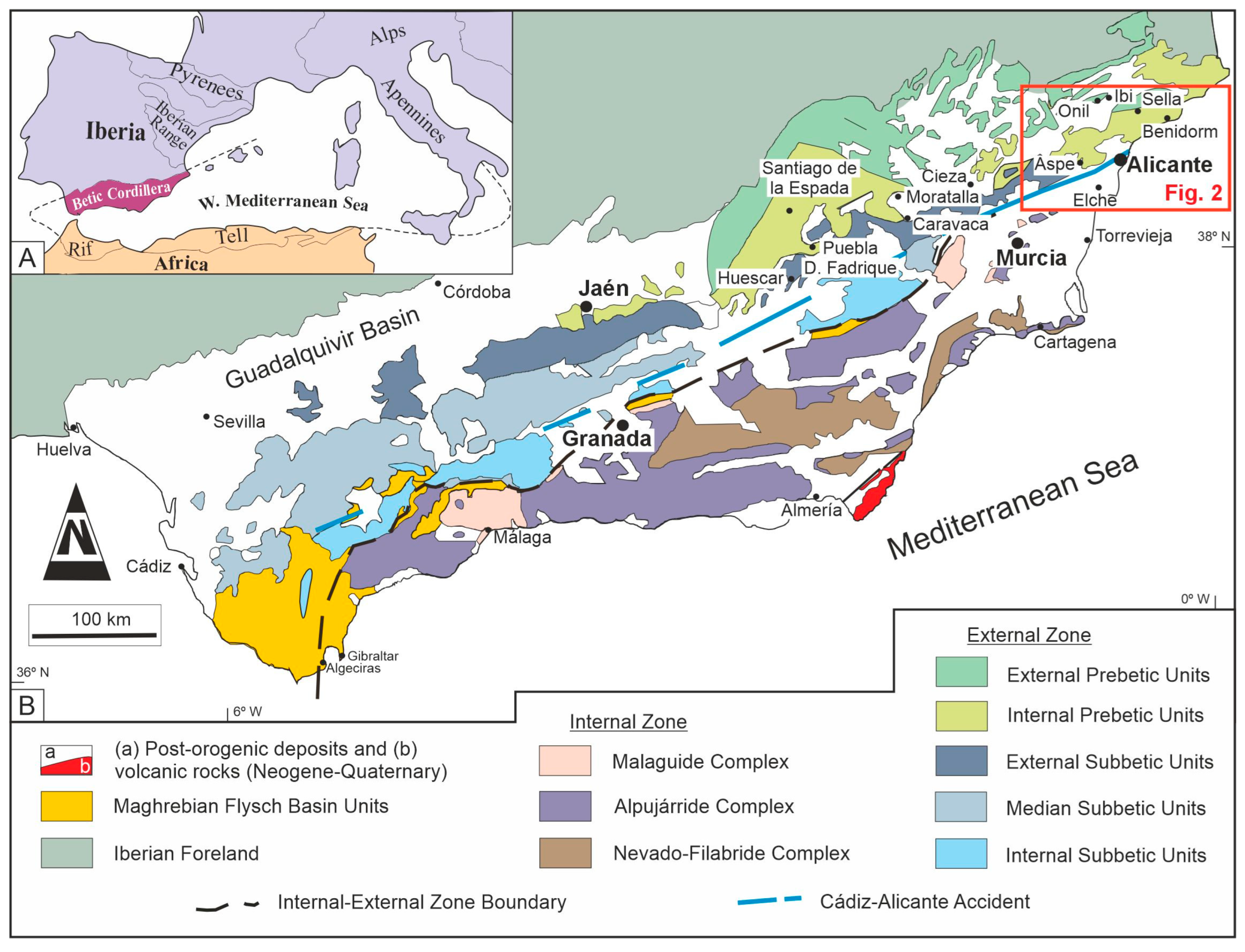
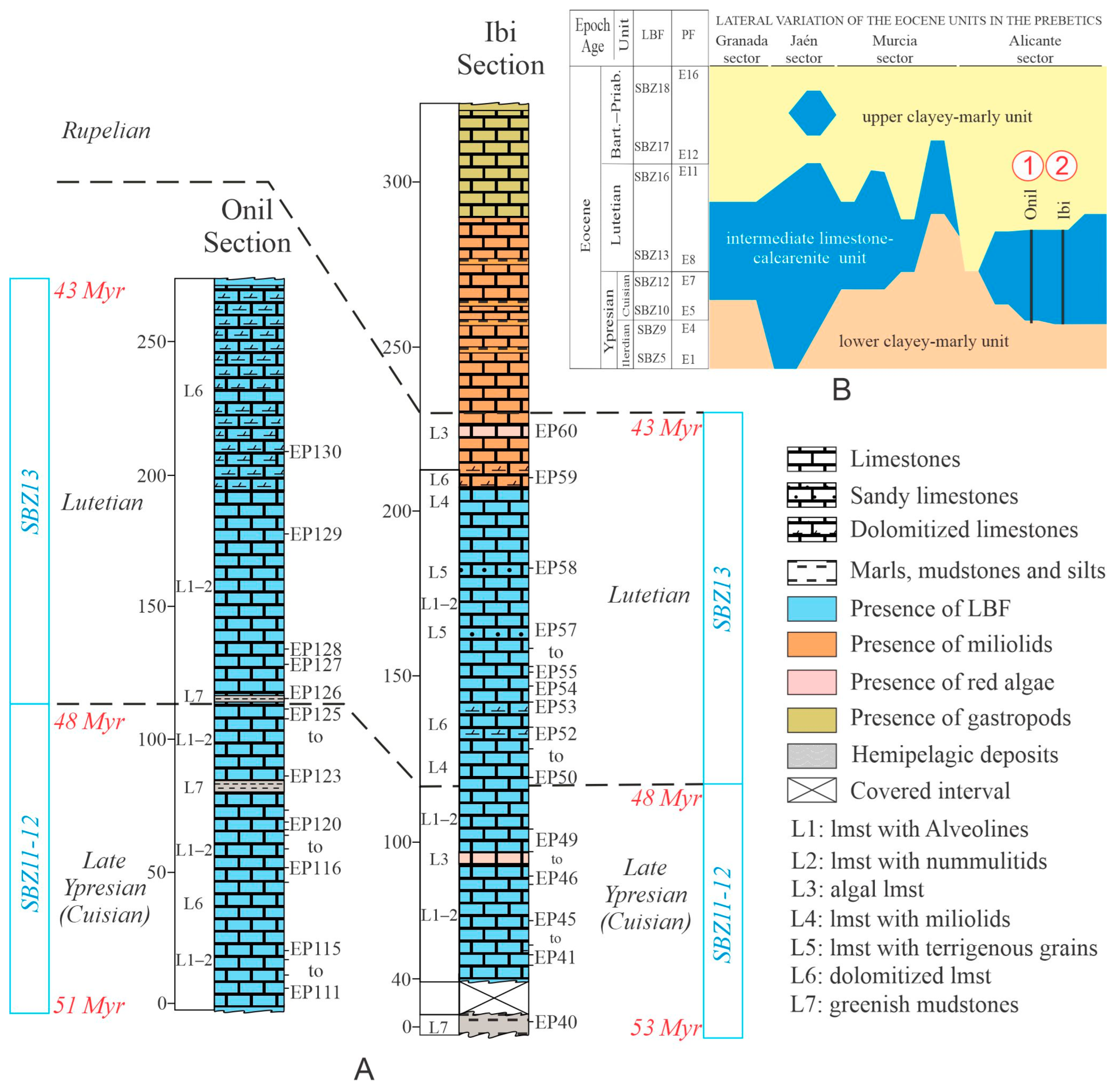

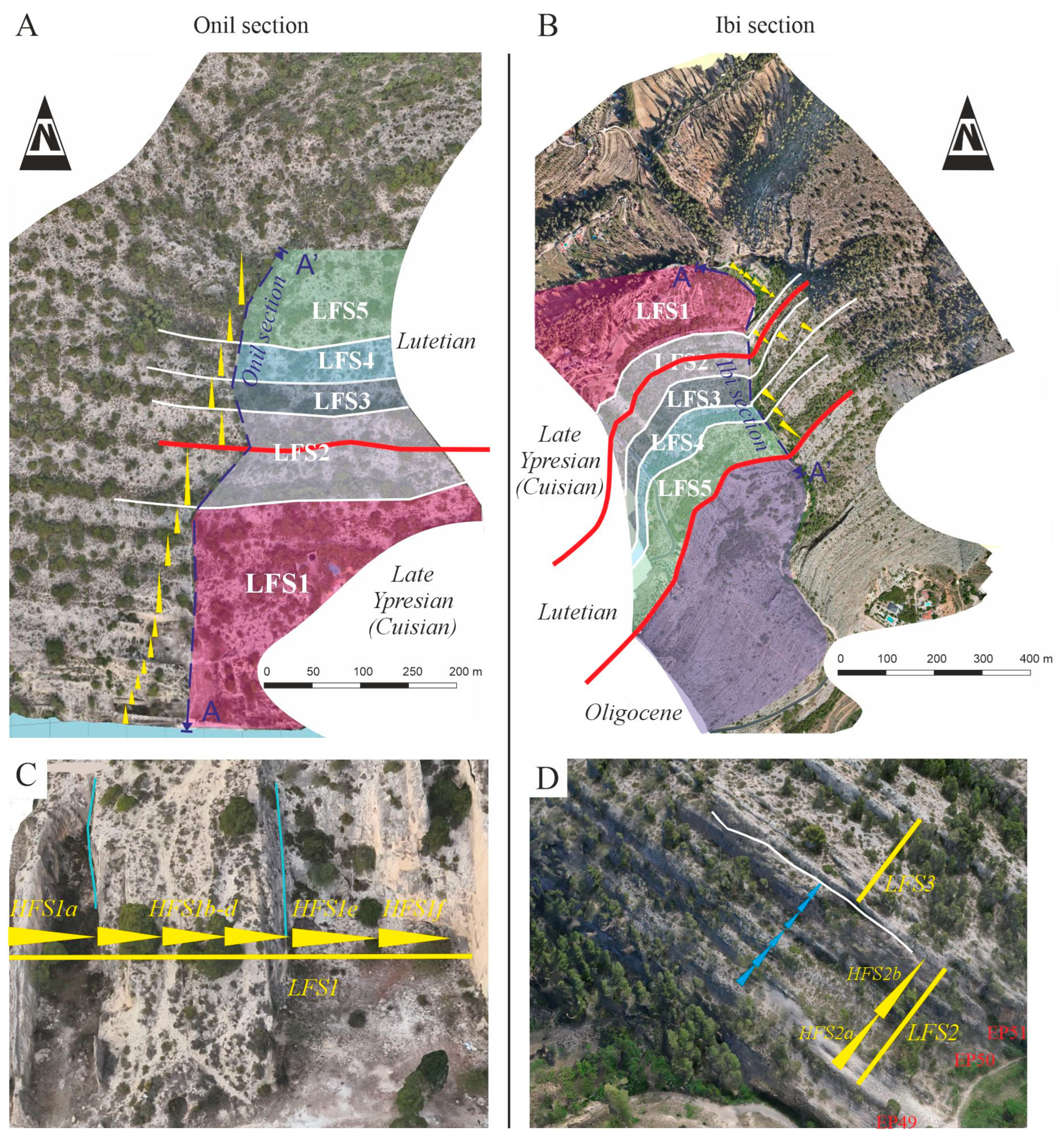
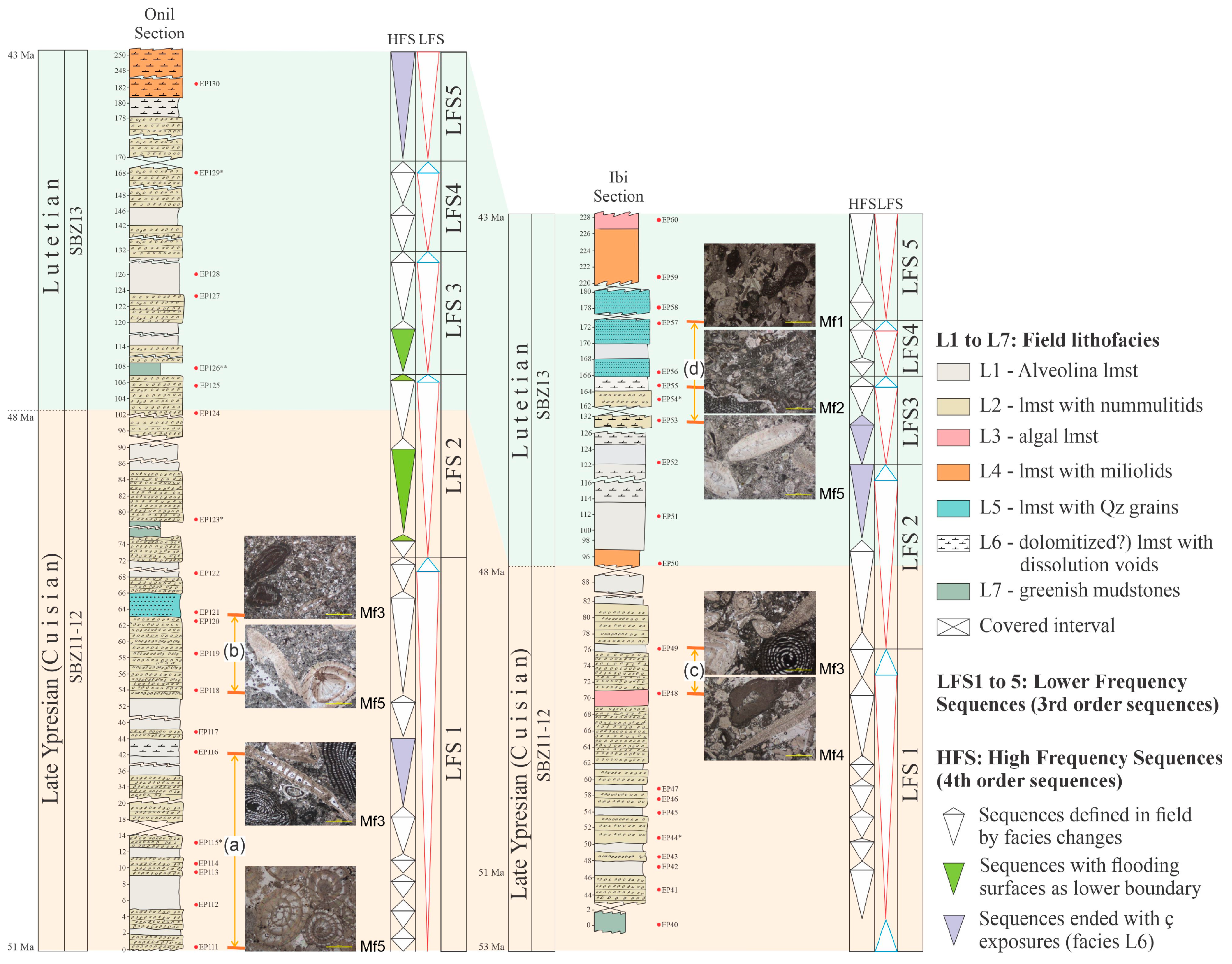

| Tool/ Flying Software | Flight | Date | Photos | Covered Area (km2) | Models | |
|---|---|---|---|---|---|---|
| Mavic DJIair2s Dronelink | Ibi1 | 3 July2022 | 242 | 0.223 | IBI-A | IBI-C |
| Ibi2 | 206 | 0.172 | ||||
| DJI Mavic3T Mavic Pilot | Ibi3 | 24 June 2024 | 1166 | 0.720 | ||
| Ibi4 | 820 | 0.490 | ||||
| Ibi5 | 384 | 0.370 | IBI-A | |||
| Ibi6 | 18 Nov 2024 | 641 | 0.290 | |||
| Ibi7 | 1 Feb 2025 | 931 | 0.400 | IBI-C | ||
| Ibi8 | 20 Feb 2025 | 584 | 0.610 | IBI-UC | ||
| Onil | 2 Jan 2024 | 659 | 0.310 | ONI | ||
| Micro- Facies (Mf) and Litho- Facies (L) | Samples EP00 | Description | Fossils and Other Components that were Common and/or Abundant (*) | Fossils and Other Components that were Present and/or Rare | Depositional Environment |
|---|---|---|---|---|---|
| Mf1 L1–2, L4–6 | 56–59 129, 130 | Limestones with alveolines, nummulitids, and miliolids. Terrigenous and dolomitized lmst. Grainstone of cortoids, miliolids, rotaliids, hooked acervulinids, and geniculate coralline algae | Miliolids *, hook-like acervulinids *, geniculate coralline algae *, Orbitolites, echinoid plates, dasyclade algae, Cuvillerina and other rotaliids *, discorbids, textulariids, cortoids *, pellets * | Unidentified small benthic foraminifera, fragmentary remains of Nummulites and corals | Shoal deposits near a seagrass environment Inner ramp |
| Mf2 L4–6 | 50–52, 55 | Limestones with miliolids. Terrigenous and dolomitized lmst. Grainstone– rudstone of porcelaneous LBF and acervulinids | Orbitolites *, Alveolina *, hook-like and annular acervulinids *, dasyclade algae *, rotaliids *, miliolids, discorbids, textulariids, gastropods, balanids, vinculariform and lunulitiform bryozoans, echinoid plates, reworked grains of Alveolina and rotaliids, compound grains, pellets, cortoids * | Nummulites, Assilina, operculiniform Assilina, Amphistegina, asterigerinids, peyssoneliacean red algae | Perennial seagrass environment Inner ramp |
| Mf3 L1–3, L7 | 125, 128 | Limestones with alveolines, nummulitids, and algae. Mudstones. Mixed hyaline–porcelaneous LBF packstone | Nummulites *, Discocyclina *, rotaliids *, Alveolina, rhodoliths, echinoid plates and spines, Solenomeris macroids, bryozoans, annelids, discorbids, miliolids | Orbitolites, Assilina, textulariids, unidentified small benthic foraminifera, encrusting acervuline remains | LBF accumulations Inner-to-mid ramp transition |
| 42, 45, 47, 49, 112, 113, 116, 121–124 | |||||
| Mf4 L1–2 | 46, 48 | Limestones with alveolines and nummulitids. Bindstone-to-rudstone of rhodoliths, acervilinids, and hyaline LBF | Rhodolith branches * of Sporolithon-Lithoporella, solenomerid macroids *, peyssoneliacean red algae, rotaliids *, Nummulites *, Discocyclina *, Assilina, operculiniform Assilina, haddonids, cibicidids, miliolids, ostracods, annelids, bivalves, gastropods, bryozoans, echinoid debris, quartz grains * | Amphistegina, Alveolina, coral grains, dasyclades, geniculate coralline algae, textulariids, unidentified small benthic and planktic foraminifera | Maërl deposits Mid ramp |
| Mf5 L1–2, L6 | 53, 54 | Limestones with alveolines and nummulitids. Dolomitized lmst. Hyaline LBF packstone–rudstone | Nummulites *, Assilina *, Discocyclina, rotaliids *, echinoid plates and spines, bryozoans, annelids, textulariids, quartz grains | Rhodolith and solenomerid macroid fragmentary remains | LBF accumulations Mid ramp |
| 41, 43, 44 111, 114, 117, 118, 120 |
Disclaimer/Publisher’s Note: The statements, opinions and data contained in all publications are solely those of the individual author(s) and contributor(s) and not of MDPI and/or the editor(s). MDPI and/or the editor(s) disclaim responsibility for any injury to people or property resulting from any ideas, methods, instructions or products referred to in the content. |
© 2025 by the authors. Licensee MDPI, Basel, Switzerland. This article is an open access article distributed under the terms and conditions of the Creative Commons Attribution (CC BY) license (https://creativecommons.org/licenses/by/4.0/).
Share and Cite
Miclăuș, C.; Tent-Manclús, J.E.; Tosquella, J.; Martín-Martín, M.; Serrano, F. Eocene Stratigraphic Sequences in the Prebetic of Alicante (SE Spain) and Their Correlation with Global Sea-Level and Climatic Curves. J. Mar. Sci. Eng. 2025, 13, 1031. https://doi.org/10.3390/jmse13061031
Miclăuș C, Tent-Manclús JE, Tosquella J, Martín-Martín M, Serrano F. Eocene Stratigraphic Sequences in the Prebetic of Alicante (SE Spain) and Their Correlation with Global Sea-Level and Climatic Curves. Journal of Marine Science and Engineering. 2025; 13(6):1031. https://doi.org/10.3390/jmse13061031
Chicago/Turabian StyleMiclăuș, Crina, José Enrique Tent-Manclús, Josep Tosquella, Manuel Martín-Martín, and Francisco Serrano. 2025. "Eocene Stratigraphic Sequences in the Prebetic of Alicante (SE Spain) and Their Correlation with Global Sea-Level and Climatic Curves" Journal of Marine Science and Engineering 13, no. 6: 1031. https://doi.org/10.3390/jmse13061031
APA StyleMiclăuș, C., Tent-Manclús, J. E., Tosquella, J., Martín-Martín, M., & Serrano, F. (2025). Eocene Stratigraphic Sequences in the Prebetic of Alicante (SE Spain) and Their Correlation with Global Sea-Level and Climatic Curves. Journal of Marine Science and Engineering, 13(6), 1031. https://doi.org/10.3390/jmse13061031






